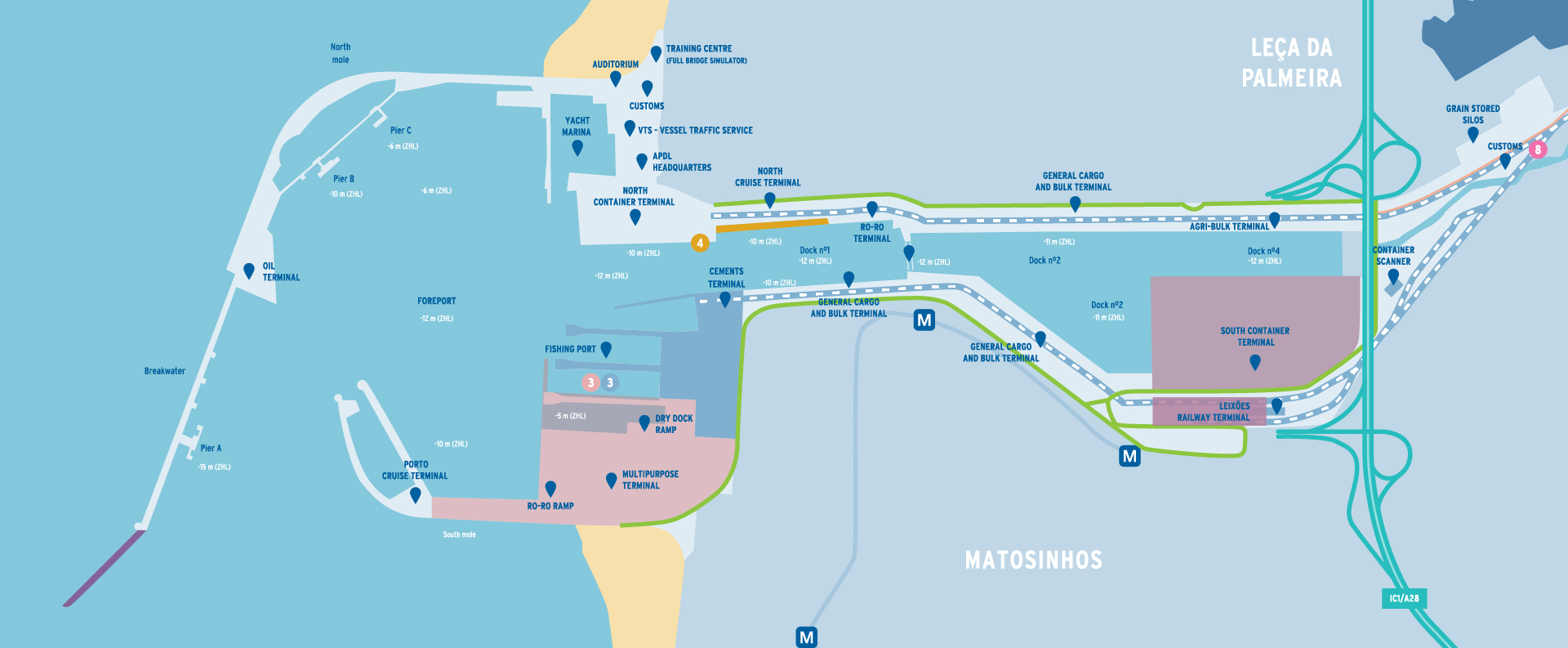-
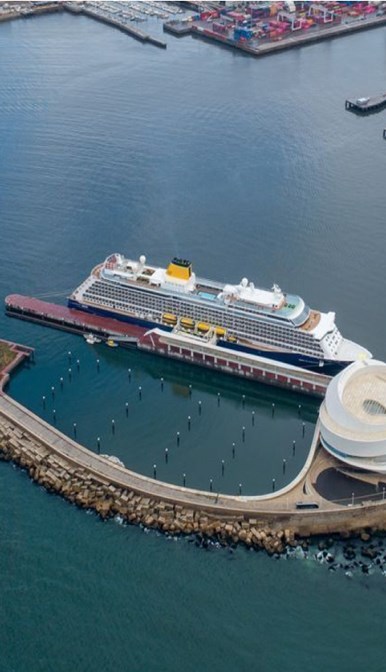
Port of Leixões
- 184 Exporting Countries
- 2 Jetties
- 2.400 Ships
Latitude - 41º 11' N Longitude - 8º 42' W
The Port of Leixões is situated in northern Portugal, northwest of the Iberian Peninsula, around 2.5 nautical miles north of the mouth of the Douro River and in close proximity to the city of Porto. It is bordered by the towns of Leça da Palmeira to the north and Matosinhos to the south.t
Coming from the north, give clearance to the Orça Rock at 130 meters outside the North Jetty, parallel to 41 degrees 10 minutes 37 seconds, passing south of the breakwater beacon.
At night, one should navigate by the lights of the breakwater beacon and the lights in the lighthouses of the North and South Jetties.
Coming from the North, give a berth to the Orça Rock at 130 meters outside the North Jetty, parallel to 41 degrees 10 minutes 37 seconds.
History
-
1879 11 February
-
1883 24 de august
-
1883 23 october
-
1884 13 july
-
1884
-
1892 31 december
-
1893
-
1895 16 february
-
1899
-
1908
-
1913 23 abril
-
1932
-
1932/1941
-
1940 4 julho
-
1955
-
1957/1962
-
1957/1962
-
1959/1961
-
1961 8 abril
-
1962/1966
-
1965/1968
-
1969
-
1974/1979
-
1974/1984
-
1986/1990
-
1992
-
2000
-
2001
-
2006 22 novembro
-
2007 30 julho
-
2008 Março
-
2009-2010
-
2010 18 september
-
2015 April
-
2015 29 august
-
2020 15 december
-
2021 7 october
-
2023 1 february
Sheltered Port of Leixões
Authorization for the opening of a tender for the construction of the Sheltered Port of Leixões, through Proposal of Law No. 74-A
Sheltered Port of Leixões
Approval of the final project authored by Engineer Afonso Joaquim Nogueira Soares for the construction of the Sheltered Port of Leixões by Mr. Minister Hintze Ribeiro
Sheltered Port of Leixões
Opening for an international tender for the definitive construction of the Sheltered Port of Leixões. The bidding base for the work was 4,500 "contos de reis"
Sheltered Port of Leixões
Commencement of the construction of the North and South jetties of the Sheltered Port of Leixões.
Titan Cranes
Dauderni & Duparchy" ordered from the famous French workshops "Fives", in Lille, two gigantic and powerful steam-powered cranes that, due to their colossal aspect, were dubbed Titans - "The main arm measures 68.75 meters in length, divided into 46 meters forward and 22.75 meters aft. The counterweight in this latter part is formed by a massive masonry block.
Sheltered Port of Leixões
The completion of the first phase of the construction of the Sheltered Port of Leixões was announced.
Porto Railway Company
The Porto Railway Company is authorized to use the railway from the São Gens quarries for the transportation of passengers and goods. The São Gens railway line began at the quarries of the same name, intersected the Póvoa Line at Senhora da Hora Station at a right angle, and continued to the sheltered port area of Leixões, totaling approximately 6 km in length. The section related to the Matosinhos Branch started at Senhora da Hora station and ended at the Sheltered Port of Leixões, with an approximate length of 5700 meters
Sheltered Port of Leixões
Final delivery of the Sheltered Port of Leixões project.
Disinfection Station
Approved project for the installation of a Disinfection Station in Leixões. The services were inaugurated in 1905.
Adaptation from Sheltered Port to Commercial Port
The plan presented by Engineer Adolfo Loureiro and Santos Viegas, which formed the basis for the subsequent development of the adaptation works of Leixões into a Commercial Port.
Transformation of Leixões into a Commercial Port
Transformation of Leixões into a Commercial Port and the creation of an entity that would manage the construction and operation of this port structure: the Autonomous Board of Maritime Facilities of the Douro and Leixões Port.
Start of construction of Dock No. 1
Construction of an extensive submerged breakwater
Inauguration of Dock No. 1
Inauguration of Dock No. 1 with the arrival of the Bartolomeu Dias warship from the navy (measuring 550 meters in length by 175 meters in width, with two berths totaling one thousand meters).
Port Expansion Approved
The General Port Expansion Plan, developed by Engineer Henrique Schreck, was approved. A key figure at APDL, having served as Director-General and Acting President.
Construction of the Expressway Viaduc
Construction of South Dock No. 2
Opening of the Moving Bridge to the Public
Opened for pedestrian traffic in 1959 and for vehicular traffic in 1961, with the official inauguration. The construction of the Moving Bridge, located between docks No. 1 and No. 2, connecting Matosinhos to Leça da Palmeira. Based on a preliminary design by Engineers Correia de Araújo and Campos Matos, it was built by the company L. Dargent.
Inauguration of the Passenger Terminal at North Dock 1.
Construction of North Dock No. 2
Construction of the Fishing Port.
Inauguration of Leixões Oil Terminal
Construção do Terminal de Contentores Norte
Construction of Dock No. 4
Construction of the first phase of the South Container Terminal (Dock 4).
Inauguration of Leixões Marina.
VTS - Vessel Traffic Service
The Vessel Traffic Service (VTS) is a maritime traffic monitoring system established by the maritime administration (DGRM), similar to air traffic control.
Inauguration of the Port Ring Road, the Infante D. Henrique Auditorium, and the Afonso Nogueira Soares Training Center.
The building of the Port of Leixões Coordination and Security Center is inaugurated
New Moving Bridge
The new Moving Bridge of Leixões enters into operation, with a span of 86.5 meters (92 meters) and approximately 1,300 tons of steel, making it the fourth largest in the world.
Inauguration of VILPL - Internal Connection Road to the Port of Leixões and the Main Gate of the Port of Leixões.
Transformation of the former workshops building into a gym, cafeteria, and bar, with a parking lot.
Inauguration of the Multi-Purpose Terminal at the south jetty and the 300m TCZ Dock
Inauguration of the Leixões Cruise Terminal building
Leixões Logistics Platform
Inauguration of the Leixões Logistics Platform (Polo I in Gonçalves and Polo II in Guifões/Gatões).
Extension of the Breakwater
The contract was signed with the consortium Teixeira Duarte - Engenharia e Construções, S.A., Dredging International NV, and Tecnovia, S.A., for the Project of Extending the Outer Breakwater and Maritime Accessibilities of the Port of Leixões, with a length of 300 meters.
Titan - The Rebirth
Inauguration of the New Titan - South Jetty (Titan - The Rebirth)
Leixões Railway Terminal
The Leixões Railway Terminal witnessed the departure of the first freight train bound for the Port of Sines, marking the beginning of the management of this infrastructure by APDL, which was previously overseen by IP.
Quays and Terminals
-
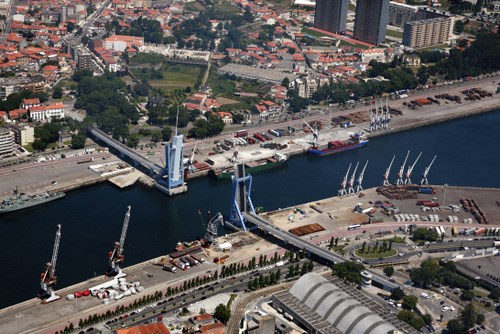
Conventional Quays for General Cargo and Bulk Solids comprise Dock 1 (North and South), Dock 2 (North and South), and Dock 4 North (or Agro-food Bulk Terminal), which are leased to TCGL - Terminal de Carga Geral e Granéis de Leixões, S.A., with the exception of Dock 1 North.
The main commodities handled here include: raw, pressed, and sawn timber; iron and steel; sheet rolls; granite stones; scrap metal; agro-food bulk goods; general machinery; and project cargoes such as wind generators and transformers.
Characteristics of the conventional quays:
Dock 1 North
- Quay length: 455 meters
- Depth: -10 meters (Z.H.L.)
- Cranage: 1 crane of 45 to 90 tons
- Open storage capacity: 17,850 m2
Dock 1 South
- Quay length: 520 meters
- Depth: -10 meters (Z.H.L.)
- Cranage: 5 cranes of 6.2 tons and 2 cranes of 16 to 40 tons
- Open storage capacity: 16,663 m2
Dock 2 North
- Quay length: 670 meters
- Depth: -11 meters (Z.H.L.)
- Cranage: 9 cranes of 6.2 tons, 2 cranes of 5 to 15 tons, and 1 crane of 42 to 104 tons
- Open storage capacity: 34,693 m2
Dock 2 South
- Quay length: 690 meters
- Depth: -11 meters (Z.H.L.)
- Cranage: 9 cranes of 6.2 tons, 4 cranes of 12 to 18 tons, and 1 crane of 29 to 104 tons
- Open storage capacity: 53,414 m2
Dock 4 North - Grain Terminal
Most of the Agro-food Bulk Solids are handled at the Grain Terminal.
- Quay length: 400 meters
- Depth: -12 meters (Z.H.L.)
- Cranage: 2 eco-friendly cranes of 15 tons with anti-pollution system
- Open storage capacity: 22,448 m2
- Covered storage capacity: Warehouse 13: 2,500 m2; Warehouse 15: 1,500 m2.
- Commodities: agro-food bulk goods.
-
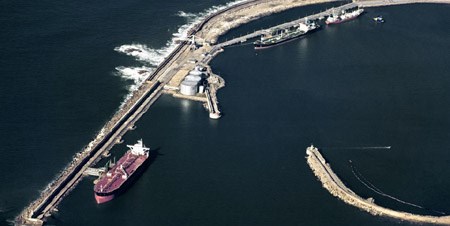
Liquid bulk goods handled at the Port of Leixões are primarily destined for the Petrogal Refinery located in Leça da Palmeira, as well as for CEPSA. In addition to the Petroleum Terminal, there are other suitable locations for handling various types of liquid bulk:
South Dock 2
- Berth length: 690 meters
- Depth: -11 meters (Z.H.L.)
- Goods: asphalt products and fuel oil
- Pipelines serving CEPSA - Companhia Portuguesa de Petróleos, Lda.
-
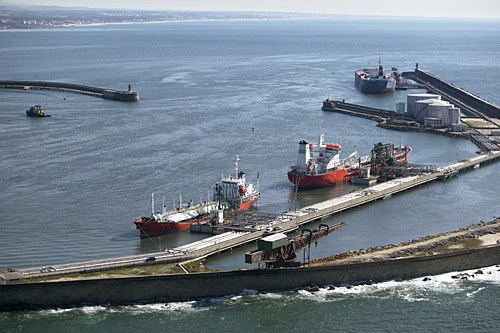
The Port of Leixões features an Oil Tanker Terminal, leased to Petrogal - Petróleos de Portugal, S.A., built on the submerged breakwater, measuring 700 meters in length and standing 15 meters above sea level, also serving as protection at the port entrance.
The Terminal, connected to the Petrogal Refinery through pipelines, has three berths:
Berth A
- Depth: -15 meters (Z.H.L.)
- Cargo: crude oil and various refined products
- Capacity for vessels: up to 100,000 DWT
Berth B
- Depth: -10 meters (Z.H.L.)
- Cargo: crude oil, various refined products, liquefied petroleum gases, and aromatic products
- Capacity for vessels: up to 27,000 DWT
Berth C
- Depth: -6 meters (Z.H.L.)
- Cargo: various refined products, liquefied petroleum gases, and aromatic products
- Capacity for vessels: up to 5,000 DWT
Galp-Leça Ocean Terminal
In 2006, the operation of unloading at the Galp-Leça Ocean Terminal (TOGL) began, aimed at receiving crude oil for the Petrogal Refinery. This berth is used by oil tankers up to 150,000 DWT and has depths of up to -30 meters.s.
-
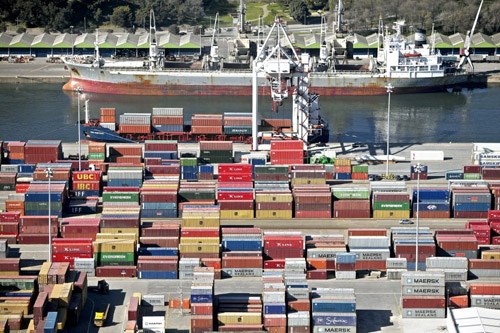
North Container Terminal
It has a 360m long berth with depths of -10m (Z.H.L.), equipped with 2 quay gantries with a capacity of up to 35/42 tonnes (on the spreader/under the beam).
Its embankments have a total area of 6 hectares and are equipped with 4 parking gantries with a capacity of 35/42 tonnes (on the spreader/under the beam) which can store 3,500 TEU'S. The terminal's handling capacity is 170,000 TEU'S per year. It also has 2 reach-stackers and 3 front-end forklifts for handling containers.The terminal also has a refrigerated container parking area with 72 power sockets and 10 semi-trailers for internal container transport.
This terminal also has a 145m-long quay in a north-south direction with a depth of -6m (Z.H.L.), which is not part of the concession.South Container Terminal
The South Container Terminal has a 540m long berth with depths at -12m (Z.H.L.), equipped with 4 quay gantries with a capacity of up to: two of 40/2x30/75 tonnes (on the single/twin-lift/under-dash spreader), one of 40/2x20/65 tonnes (on the single/twin-lift/under-dash spreader) and one of 35/45 tonnes capacity (on the spreader/under-dash). Its embankments, with a total area of 16 hectares, are equipped with 14 parking gantries with a capacity of 35/45 tonnes (on spreader/under bar). It also has 7 reach-stackers and 6 front-end forklifts, making it possible to store 14,100 TEU'S.
The terminal's handling capacity is 600,000 TEU'S per year. This terminal also has a refrigerated container parking area with 544 power sockets and 28 semi-trailers for internal container transport.
This terminal also has a 100m long quay, running north-south with a depth of -11m (Z.H.L.), located at the eastern end of Dock no. 2, which is not part of the concession. -
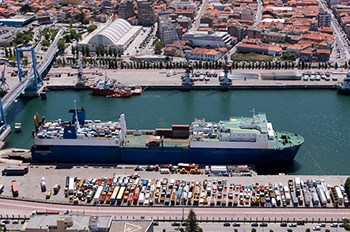
The Roll-On Roll-Off Terminal is located at Dock 1 North, which has a depth of -10m, providing roll-on roll-off cargo loading and unloading services at Porto de Leixões. This terminal offers suitable conditions for the berthing of Ro-Ro vessels with stern ramps and features a fixed platform integrated into the quay with a length of 21m, maximum width of 22m, and a slope of 7.7%.
The maximum cargo capacity of this terminal is 80 tons and 24 tons per axle. It also has a parking area for approximately 100 trailers.
Dock 1 North:
- Depth: -10m
- Fixed platform: maximum width of 22 meters and minimum of 11 meters with a slope of 7.7%
- Cargo: light vehicles and heavy equipment (trucks and trailers)
- Parking area for 100 trailers
-
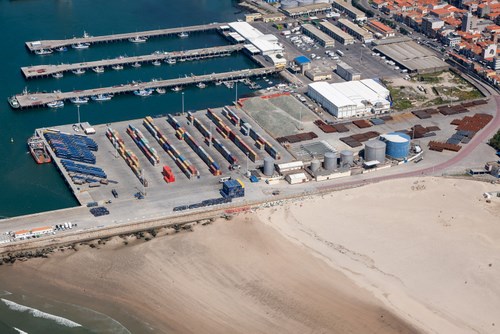
The Multi-Purpose Terminal is primarily intended for Ro-Ro traffic, promoting the development of Motorways of the Sea from Leixões. Situated on the South Breakwater of Porto de Leixões, it features an advanced quay with a length of 310 meters, a Ro-Ro ramp measuring 26 meters in width, depths of -10 meters (Z.H.L.), and the capacity to handle equipment weighing up to 360 tons. Additionally, it includes a quay perpendicular to the South Breakwater with a length of 155 meters and depths of -10 meters, another quay with a length of 50 meters, and a slipway ramp.
This terminal is primarily dedicated to Short Sea Shipping (SSS), serving both Ro-Ro and Lo-Lo (Lift-On/Lift-Off) operations. It also has a yard area of approximately 8 hectares that serves as a support area.
-
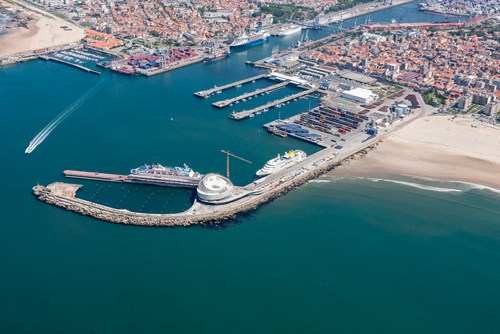
Each year, the Port of Leixões welcomes around 80,000 cruise ship passengers from all over the world. The majority of passengers come from the United Kingdom, Germany, and the United States of America.
For this purpose, Leixões has two cruise terminals:
North Cruise Terminal
Located at Dock 1 North, this terminal features a 300-meter-long quay with a depth of -10 meters, capable of receiving ships with a maximum length of 250 meters. To accommodate passengers, this terminal also includes a Passenger Station, considered an Architectural and Historical Heritage of the city of Matosinhos. The Leixões Passenger Station, designed by architects Tito Figueiredo and Jorge Gigante, was inaugurated in April 1961 and is a valuable example of architecture from that period, built in wood, with large glass windows that allow passengers to enjoy the movement of the port and the beauty of the sea.
Dock 1 North
- Quay length: 300 meters
- Depth: -10 meters (Z.H.L.)
- Maximum length of ships: 250 meters
- Draft: 8 meters (at high tide, 9 meters)
South Cruise Terminal
This modern cruise terminal is located on the south pier and reflects APDL, SA's commitment to promoting the cruise industry in the Northern region of Portugal. This is the largest project ever to open the Port of Leixões to the city, increasing its capacity to accommodate larger cruise ships. The new cruise ship pier was inaugurated in April 2011 and has since welcomed the largest and most luxurious cruise ships in the world. The main building features a Passenger Station with various facilities for ships in transit or those embarking/disembarking passengers. There is no capacity limit for transit passengers, and the terminal can accommodate up to 2,500 passengers in turnaround (embarking and disembarking). Also housed in this building are the Production and Science (offices and experimental laboratories) and Scientific Outreach Departments of CIIMAR - Interdisciplinary Center for Marine and Environmental Research.
- Cruise Ship Pier
- Pier length: 340 meters
- Depth: -10 meters (Z.H.L.)
- Maximum length of ships: 300 meters for berthing
- Mandatory piloting (for entry and exit)
- No stay limits
- ISPS certification
- Passenger Station, located in the central building of the complex, with various facilities for ships in transit or those embarking/disembarking passengers. There is no capacity limit for transit passengers, and it can accommodate up to 2,500 passengers in turnaround (embarking and disembarking).
- Fluvial-Maritime Pier for mooring boats that provide tourist itineraries on the Douro River.
- Nautical Recreation Port for 170 boats and respective minimum support services, convenience spaces, and support functions for crew and sailors.
- Parking for buses and vehicles along the pier and interior parking.
-
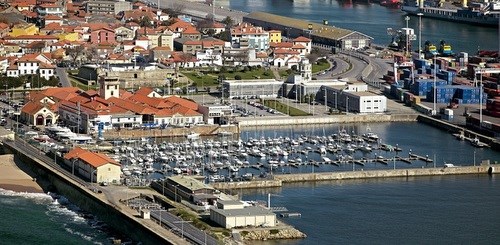
The Marina Dock, located at the root of the North Pier of the Port of Leixões, is leased to the Atlantic Marina Club Association. It is bounded by the North, West, and East docks (clubs) and the Tide Gauge. This infrastructure consists of a set of floating elements (piers) and horizontally stabilized "fingers" connected to a system of metal piling driven into the rocky bottoms of the area. It allows for the supply of drinking water, fuel, and low-voltage electrical energy to boats and is equipped with firefighting equipment and containers for waste and oils.
- Quay Length: 50 meters.
- Depth: -2.5 meters (Z.H.L)
- Mooring Capacity: 248 permanent mooring places, with an additional area of pontoon bridges totaling 50 meters in length for temporary mooring, accommodating 4 to 5 yachts.
- Services/Equipment: Provision of drinking water, low-voltage electrical energy, firefighting system, and containers for waste and oils.
-
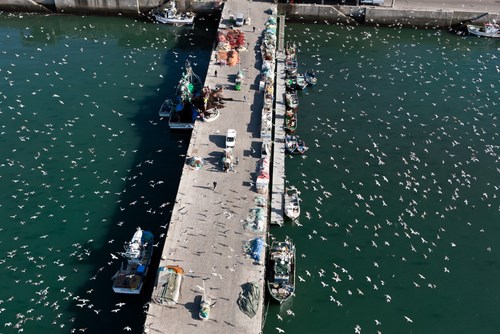
Concessioned to DOCAPESCA – Portos e Lotas, S.A., Matosinhos is the primary fishing port in terms of the overall quantity of fish caught. It is the most significant sardine port in the country and the largest in catches by coastal trawling. It features three quay walls totaling 1,890 meters in length and depths of -4 meters (ZHL), where 46 trawlers and 20 trawlers can simultaneously dock. Floating platforms have also been installed for artisanal fishing vessels. The fish auction ensures increased productivity of services provided in the best working and hygiene conditions. The level of innovation extends to a modern computerized electronic auction system. The cold storage warehouse and freezing unit, in turn, already ensure ice supply and have a storage capacity of 5,500 tons.
-
SILOS PORTUÁRIOS
The company Silos de Leixões - Unipessoal, Lda operates in an area of 2.3 hectares. The silos are designed for the storage of cereals, derivatives, oilseeds, and other food products and have a capacity of 120,000 tons (100,000 tons in vertical silos and 20,000 tons in a horizontal warehouse).
PETROGAL - PETRÓLEOS DE PORTUGAL, S.A.
Products manufactured at the Leça da Palmeira Refinery, connected to the Oil Terminal by twenty oil and gas pipelines, are shipped to national ports (exchange between refineries, Petrogal, S.A. storage parks, and other third-party facilities) to supply the domestic market or to foreign ports for export, with a predominance of base oils and chemical products.
BULK PETROLEUM PRODUCTS DEPOT
CEPSA - Companhia Portuguesa de Petróleos, S.A. located in Matosinhos, near the Port of Leixões, is connected to South Dock 2 by two pipelines for asphalt products and fuel oil. The storage capacity is 61,000 tons.
CEMENT WAREHOUSE
Located in South Dock 1, there are two warehouses for the reception and dispatch of bulk cement, licensed to SECIL - Companhia Geral de Cal e Cimento, S.A., occupying a total area of about 1,500 square meters.
